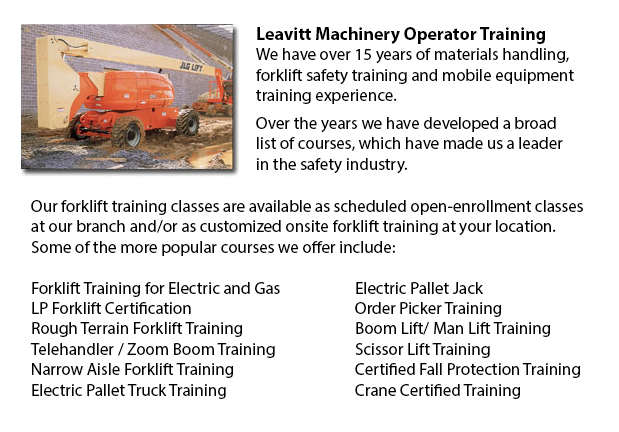
Grande Prairie Boom Lift Certification - The use o elevated work platforms allow for work and maintenance operations to be carried out at elevated work heights that were otherwise not reachable. Boom Lift Certification Training teaches workers regarding safely operating scissor lifts and boom lifts.
Despite the range in lift style, site conditions and applications, all lifts have the potential for serious injury or death when operated unsafely. Falls, electrocution, crushed body parts, and tip-overs can be the unfortunate result of improper operating procedures.
To be able to avoid aerial lift incidents, individuals need to be qualified to train workers in operating the certain type of aerial lift they would be using. Controls should be easily accessible beside or in the platform of boom lifts used for carrying workers. Aerial lifts should never be modified without the express permission of other recognized entity or the manufacturer. If you are leasing a lift, make certain that it is maintained correctly. Before utilizing, controls and safety devices should be checked to make sure they are correctly functioning.
It is important to follow safe operating procedures in order to avoid workplace accidents. Driving an aerial lift while the lift is extended should not be done, nonetheless, some models are designed to be driven when the lift is extended. Always set brakes. Set outriggers, if available. Avoid slopes, but when needed utilize wheel chocks on slopes which do not go beyond the slope limits of the manufacturer. Follow weight and load limitations of the manufacturer. When standing on the boom lift's platform, make use of full-body harnesses or a safety belt with a two-foot lanyard tied to the basket or boom. Fall protection is not required for scissor lifts that have guardrails. Do not climb or sit on guardrails.
This course consists of the following topics: safety guidelines to be able to prevent a tip-over; training and certification; checking the work area and travel path; surface conditions and slopes; other guidelines for maintaining stability; stability factors; weight capacity; leverage; testing control functions; pre-operational check; safe operating practices; mounting a motor vehicle; power lines and overhead obstacles; safe driving procedures; PPE and fall protection; making use of lanyards and harness; and preventing falls from platforms.
When successful, the trained worker will know the following: pre-operational inspection procedures; training and authorization procedures; how to avoid tip-overs; factors affecting the stability of boom and scissor lifts; how to utilize PPE, how to utilize the testing control functions and strategies in order to prevent falls.
-
Grande Prairie Overhead Crane Safety Training
Grande Prairie Overhead Crane Safety Training - Overhead crane safety training equips operators with skills and knowledge about crane safety measures, accident avoidance, materials handling, and machine and stock protection. Trainees will learn the k... More -
Grande Prairie Crane License
Grande Prairie Crane License - The crane operator needs to have been certified with a crane operator license or certification. To be able to practice as an operator of a crane, the qualifications are considered mandatory. Obtaining a license includes... More -
Grande Prairie Heavy Equipment Training
Grande Prairie Heavy Equipment Training - The two most common types of heavy equipment training are classed into the categories of machines; equipment which is fashioned with rubber tires or those with tracks. The tracked vehicle are heavy duty machi... More -
Grande Prairie Skid Steer Ticket
Grande Prairie Skid Steer Ticket - On a skid-steer loader, the lift arms are beside the driver along with pivot points at the back of the driver's shoulders. This makes them different compared to a conventional front loader. Because of the operator's... More -
Grande Prairie Zoom Boom Ticket
Grande Prairie Zoom Boom Ticket - Zoom Boom Training is intended to train operators on variable reach forklifts. The objectives of the training are to impart an understanding of the physics of the equipment, and to be able to outline the operator's t... More -
Aerial Lift / Boom Lift / Man Lift / Scissor Lift Certification in Grande Prairie
Scissor lifts are lift truck tables that raise materials and people and supplies vertically. They are usually used in commercial, industrial and construction environments. A common use of scissor hoists is for lifting or lowering construction supplie... More -
Grande Prairie Aerial Lift Safety Training
Grande Prairie Aerial Lift Safety Training - Each and every year, there are roughly 26 construction fatalities due to the utilization of aerial lifts. Most of the craftsmen killed are laborers, electrical workers, ironworkers, carpenters or painters.... More -
Grande Prairie Fall Protection Ticket
Grande Prairie Fall Protection Ticket - The number one reason of death within the construction business come from fall-related incidents. There is more chance for fall accidents depending upon the kinds of work being done in your workplace. Therefore... More

Forklift Certification Grande Prairie
TOLL FREE: 1-888-254-6157
Grande Prairie, Alberta
forkliftcertificationgrandeprairie.com
Email Us
About Us


